Related Research Articles
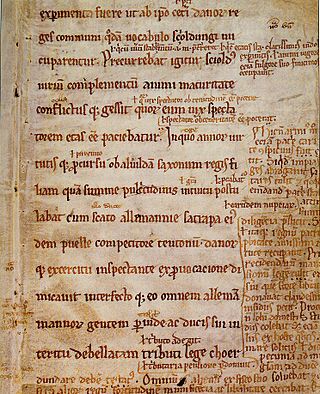
Gesta Danorum is a patriotic work of Danish history, by the 12th-century author Saxo Grammaticus. It is the most ambitious literary undertaking of medieval Denmark and is an essential source for the nation's early history. It is also one of the oldest known written documents about the history of Estonia and Latvia.
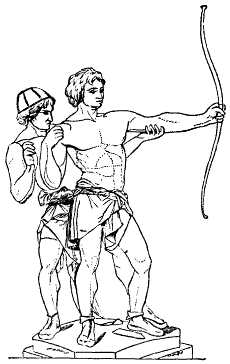
Höðr is a god in Norse mythology. The blind son of Odin, he is tricked and guided by Loki into shooting a mistletoe arrow which was to slay the otherwise invulnerable Baldr.

Ragnar Lodbrok, according to legends, was a Viking hero and a Swedish and Danish king.
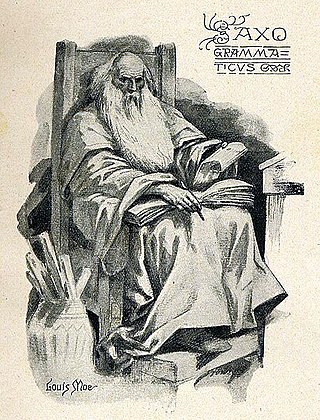
Saxo Grammaticus, also known as Saxo cognomine Longus, was a Danish historian, theologian and author. He is thought to have been a clerk or secretary to Absalon, Archbishop of Lund, the main advisor to Valdemar I of Denmark. He is the author of the Gesta Danorum, the first full history of Denmark, from which the legend of Amleth would come to inspire the story of Hamlet by Shakespeare.
Gjálp and Greip are two jötnar in Norse mythology and the daughters of the jötunn Geirröðr. They are killed by the thunder god Thor for trying to kill him.
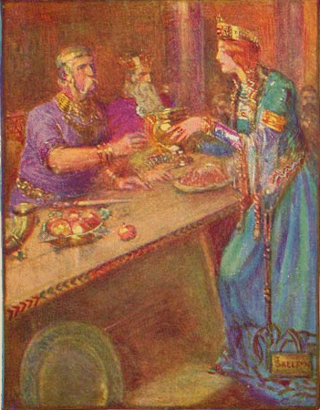
Hrothgar was a semi-legendary Danish king living around the early sixth century AD. Many years later, Hrothgar paid money to the Wulfings to resolve a blood feud they had with Ecgtheow, Beowulf's father.

Amleth is a figure in a medieval Scandinavian legend, the direct inspiration of the character of Prince Hamlet, the hero of William Shakespeare's tragedy Hamlet, Prince of Denmark. The chief authority for the legend of Amleth is Saxo Grammaticus, who devotes to it parts of the third and fourth books of his Gesta Danorum, completed at the beginning of the 13th century. Saxo's version is supplemented by Latin and vernacular compilations from a much later date. In all versions, prince Amleth (Amblothæ) is the son of Horvendill (Orwendel), king of the Jutes. It has often been assumed that the story is ultimately derived from an Old Icelandic poem, but no such poem has been found; the extant Icelandic versions, known as the Ambales-saga, or Amloda-saga are considerably later than Saxo. Amleth's name is not mentioned in Old-Icelandic regnal lists before Saxo. Only the 15th-century Sagnkrønike from Stockholm may contain some older elements.
Chronicon Lethrense is a small Danish medieval work from the late 12th century, written in Latin.
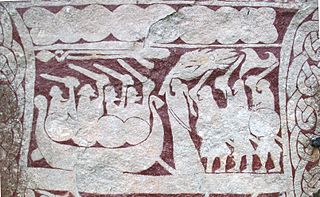
Hjaðningavíg, the legend of Heðinn and Hǫgni or the Saga of Hild is a Germanic heroic legend about a never-ending battle which is documented in Sörla þáttr, Ragnarsdrápa, Gesta Danorum, Skíðaríma and in Skáldskaparmál. It is also held to appear on the image stone at Stora Hammar on Gotland. Moreover, it is alluded to in the Old English poems Deor and Widsið, and in the Old Norse Háttalykill inn forni, and a version of it survived down to the 18th century in the traditional Norn language ballad "Hildina". An altered version of the saga is found in the Middle High German poem Kudrun, as a prologue to the story of Kudrun herself. Yet another version is found in the Old Yiddish Dukus Horant.

Thyra was the wife of King Gorm the Old of Denmark, and one of the first queens of Denmark widely believed by scholars to be historical rather than legendary. She is presented in medieval sources as a wise and powerful woman who ordered the building or fortification of the Danevirke, consistent with her commemoration on multiple Viking Age runestones. These include those at Jelling which was the seat of power for her dynasty.

Wermund, Vermund or Garmund is an ancestor of the Mercian royal family, a son of Wihtlaeg and father of Offa. The Anglo-Saxon Chronicle makes him a grandson of Woden, but the Gesta Danorum written by Saxo Grammaticus goes no further than his father, while the Brevis Historia Regum Dacie of Sven Aggesen makes Wermund son of king Frothi hin Frokni.

The Angles were a dominant Germanic tribe in the Anglo-Saxon settlement of Britain, and gave their name to the English, England and to the region of East Anglia. Originally from Angeln, present-day Schleswig-Holstein, a legendary list of their kings has been preserved in the heroic poems Widsith and Beowulf, and the Anglo-Saxon Chronicle.

Skjöldr was among the first legendary Danish kings. He is mentioned in the Prose Edda, in Ynglinga saga, in Chronicon Lethrense, in Sven Aggesen's history, in Arngrímur Jónsson's Latin abstract of the lost Skjöldunga saga and in Saxo Grammaticus' Gesta Danorum. He also appears in the Old English poem Beowulf. The various accounts have little in common.
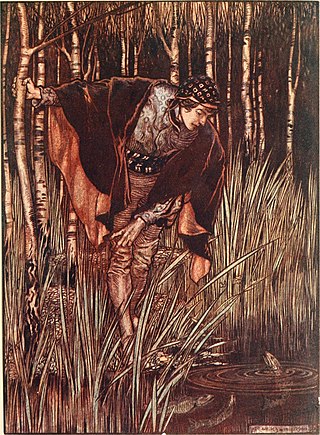
"The White Snake" is a German fairy tale collected by the Brothers Grimm and published in Grimm's Fairy Tales. It is of Aarne–Thompson type 673, and includes an episode of type 554.
Harðgreipr is a jötunn in Norse mythology. In Gesta Danorum, she is the daughter of the jötunn Vagnophtus and the nurse of the Danish hero Hadingus.
Wihtlæg, Whitlæg, Wighlek, Wiglecus, Wiglek, Witlac or Viglek is a legendary king of either Denmark or Angeln in Germanic legends. He is known in Saxo's kings of Denmark by the name of Vigletus.

Lagertha, according to legend, was a Viking ruler and shield-maiden from what is now Norway, and the onetime wife of the famous Viking Ragnar Lodbrok. Her tale was recorded by the chronicler Saxo in the 12th century. According to the historian Judith Jesch, Saxo's tales about warrior women are largely fictional; other historians wrote that they may have a basis in tales about the Norse deity Thorgerd.
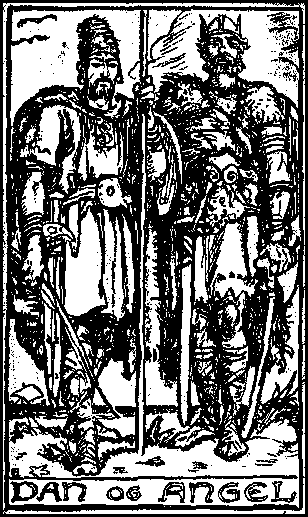
Angul is a figure in Nordic mythology who, according to the Gesta Danorum was the ancestor of the Danes, along with his brother Dan. He was also the ancestor of the Angles in Denmark, who later migrated to Great Britain, naming the land they settled England.
Rusla, also known as the "Red Woman" from Middle Irish Ingean Ruagh, was a legendary Norwegian shield-maiden mentioned in the Gesta Danorum or "History of the Danes" of Saxo Grammaticus and in the Irish annals. According to Saxo, Rusla was the daughter of a fifth or sixth century king of Telemark called Rieg, and sister of Tesandus (Thrond), who was dispossessed of his throne by a Danish king named Omund. Rusla formed a pirate fleet to attack all Danish ships as revenge for the affront to her brother. Rusla was always accompanied by another woman, Stikla, who was her deputy in all raids. Stikla turned to piracy to avoid marriage, and her name is the origin of the Norwegian city of Stiklestad.
Porevit, Porovit or Borovit is a Slavic god with unknown functions mentioned in only two sources: Gesta Danorum and in Knýtlinga saga. The only historical information about this god is a description of a statue depicting him that had five faces and no weapons.
References
- ↑ Sir Israel Gollancz (1898). Hamlet in Iceland: being the Icelandic romantic Ambales saga, p. 36. AMS Press. ISBN 978-0-404-56502-2 . Retrieved 6 December 2012.
- ↑ Jean Gabbert Harrell (31 January 2008). Profundity: A Universal Value. Penn State Press. pp. 146–. ISBN 978-0-271-02840-8 . Retrieved 6 December 2012.
- 1 2 3 4 Antonio Ballesteros González; Lucía Mora González (2001). Popular Texts in English: New Perspectives. Univ de Castilla La Mancha. pp. 30–. ISBN 978-84-8427-126-0 . Retrieved 6 December 2012.
- 1 2 3 4 5 Chambers, R. W., Beowulf, p. 39, Cambridge University Press, 1959.
- ↑ Gesta Danorum, Book IV (ed. Holder, Alfred., p. 102).